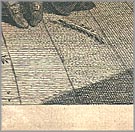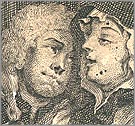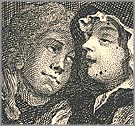 |
|||||||||||||||||||||||||||
 |
|||||||||||||||||||||||||||
|
|||||||||||||||||||||||||||
© Great Caricatures
2023
In Development • In Development • In Development
![]() WILLIAM
HOGARTH PRINTS
WILLIAM
HOGARTH PRINTS ![]()
Lifetime Editions & Print States
L |
ike many of history’s successful artists, William Hogarth’s aesthetic |
interests were intricately linked to his business concerns. He published prints to bring his art to as wide an audience as possible and to generate a renewable source of income. Hogarth composed his major works on canvas. When he finished a painting he, or his hired engravers, carefully engraved the images onto copper plates. When an inked plate transferred the image to paper, the composition was reversed: elements positioned on the right side of the canvas appeared on the left-side of the print. Later, when other artists copied his prints, the process would again reverse the image so that the composition of the copies often matched the paintings. From 1720 until his death in 1764, Hogarth published multiple editions of his work as individual prints, suites of prints, and bound volumes. Print States As Hogarth engraved his plates he worked through ideas and experimented with rendering techniques. When the image reached a stage of completion, he inked the plate and pulled a print. This maked the first state of the print. Subsequent changes that appear on later prints represent additional states. Most prints went through three or four states, but some went through as many as eight states. An image could undergo several states before it was publicly issued. Or years after Hogarth first issued a print, he would publish subsequent editions, often reworking the plates and creating additional states. Most of the differences between states are subtle, but on some plates Hogarth made significant changes that altered the content of the work. Over the course of his lifetime Hogarth made hundreds of changes to his plates. The definitive reference that documents the states of each print is Hogarth's Graphic Works by Ronald Paulson. The extremely detailed text and an abundance of illustrations make it an invaluable tool for understanding the publication history of Hogarth's prints. Gulielmus Hogarth and The Bruiser In 1749, Hogarth engraved a self-portrait that he used as a frontispiece for bound volumes of his prints. In 1763 he burnished out the dog, the curtain, and the palette. In the empty oval he engraved Churchill with a beer in one hand and a club in the other to represent a drunken clergman who writes brutal satires. The subscriber's edition of A Harlot's Progress was published in 1732. When Hogarth re-published the series in 1744, he designated the second edition by placing a small Latin cross beneath the center of each image. Before releasing the prints to the public, he made additional changes to several of the plates. Some of the modifications made to Plate 6 include a cast shadow that was added to the bottle in the lower-right corner. Shadows have also been added to the faces of the undertaker, his companion and others. |
|
"The Bruiser" 3rd state, 1763 |
|||||||||||||||||||||||
 Detail of Palette 3rd state |
 Detail of Palette 7th state |
||||||||||||||||||||||
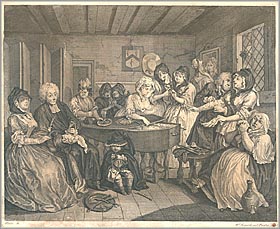 The Harlot's Progress, Plate 6 1st state, 1732 |
|||||||||||||||||||||||
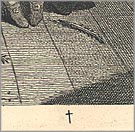
Detail of Latin Cross
A
Harlot's Progress
Plate 6
2nd state, 1744
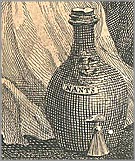
Detail of Bottle
A Harlot's Progress
Plate 6
1st state, 1732
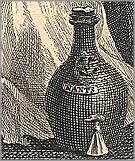
Detail of Bottle
A Harlot's Progress
Plate 6
3rd state, 1744
"Of Hogarth's lesser plates many were destroyed. When he wanted a piece of copper on a sudden, he would take any from which he had already worked off such a number of impressions as he supposed he should sell. He then sent it to be effaced, beat out, or otherwise altered to his present purpose."
John Nichols, Biographical Anecdotes of William Hogarth, p. 99
In the 2nd state of Evening, the posts in the water in the lower right are shaded with few parallel lines, but in the 3rd state the posts are cross-hatched, and in the 4th state a later publisher has removed Price 5 Shillings from the lower right-hand corner.
In the 3rd state of The Bruiser a painter's palette is shown in the lower-right corner of the image. In the 4th state a framed picture was engraved over the palette.
If Hogarth significantly reworked a plate after its initial publication, the date at the bottom of the print was changed.
Hogarth published his prints on heavy French laid paper. He also published inexpensive Shilling prints on light French laid paper.
When Hogarth died in 1764 he left his wife Jane over 200 engraved plates.










